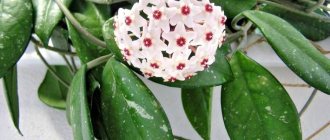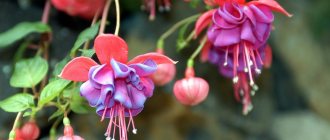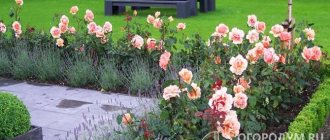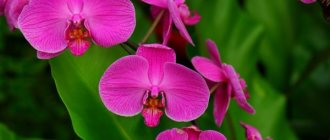Campsis is a wonderful liana with beautiful and large flowers that grows in the south of the Russian Federation. Most often it can be seen in the Krasnodar Territory and Crimea. The name is taken from the Greek language, where “kamptein” means “bending, twisting.” This plant prefers warmth, but the varieties bred by breeders have made it possible to grow it in the middle regions of Russia and even in Siberia.
Campsis is often called Tecoma or Tecomaria, but it is a similar plant belonging to a different genus. These vines belong to the Bignoniaceae family. Both genera Campsis and Tekoma have been known in Europe since the 17th century, where they are used for vertical gardening of fences, walls, pillars, and are used in landscape design on figured supports.
Liana Kampsis: description
This is a deciduous woody vine, its length can reach up to 12 meters. Branching Campsis are also found. Fastening to the supports is carried out using small air roots. The Campsis flower is a honey plant that attracts insects: bees, wasps, flies, ants. Flowering duration is 3 months, from June to September. This perennial plant consists of:
- The leaves are odd-pinnate, compound, reaching a length of up to 30 cm, consisting of 7-11 medium-sized leaves, up to 6 cm. They are dark green, smooth on top and light, slightly hairy below.
- The flowers are odorless. Tubular, similar to “gramophones”, collected in short panicles, concentrated at the tips of the shoots, up to 10 in length, with a diameter of 5 cm. The color depends on the variety of vine and can be orange-red (natural color), pink, crimson, red-golden. Reddish veins run along the inner surface from the center. The bracts look like green leaflets, and in some cases almost the same color as the “gramophone”.
- The fruits have the shape of a leathery, elongated up to 10 cm, pod, which consists of two halves. Inside it are flying winged seeds. When it bursts, they spread throughout the entire area.
A description of Campsis would be incomplete without pointing out that the stem of the vine is initially green-brown, but as it grows it becomes woodier and becomes much darker.
Types and varieties of Campsis
This flowering vine has been cultivated in Europe for about 300 years. It should be noted that the genus Campsis has two species, differing in shape from each other. From them, using selective selection, hybrids were bred that retained all the main characteristics and were bred exclusively for flowers. Let's look at each genus separately.
Campsis rooting
Its homeland is the North American continent, where it can be found in the wild. A large plant, reaching a length of up to 12 meters. It has aerial roots, with the support of which it is fixed on supports. The odd-pinnate leaves reach 20 cm in length, they are darkish above and light below. Rarely pubescent over the entire surface of the lower part, or thin hairs are located partially along the veins of the leaves.
The flowers have a tubular-funnel-shaped configuration with a length of up to 10, a diameter of up to 5 cm. The corolla is orange in color and ends with bright red flaps. Flowers in the amount of 10-15 pieces are concentrated in the upper part of the shoot. Flowering occurs gradually. This allows the vine to remain elegant until autumn. Based on this genus, the following varieties were bred:
- Fabulous . In appearance it looks like a shrub with thin and rather long branches with orange-red flowers;
- Flamenco . Campsis has bright orange-purple flowers and can bloom until frost;
- Early . It got its name because flowering occurs almost a month earlier than other varieties. It has all shades of red: scarlet, porphyry, red;
- Golden . Blooms with beautiful yellow bright flowers;
- Dark purple . It has all the characteristics of the original species, but the flowers are large and their color is purple;
- Judy . Campsis is a vigorous vine. Its length reaches 15 meters or more. The characteristic features correspond to the rooting genus. It has an original coloring of flowers - an orange neck and bright yellow lapels.
Campsis rooting Flamenco
Campsis rooting Judy
Campsis rooting Magnificent
Large-flowered (Chinese)
The basic species is found naturally in Japan and China. The main difference from the rooting Campsis:
- absence of air roots;
- less resistant to cold;
- flowers larger than those of its fellow, yellow-orange shades;
- The vine is not long, so it mostly looks like a bush.
For other characteristic features it is identical to the rooting genus. Its peculiarity is the massive blooming of all flowers. The bush is almost completely covered with flowers. The duration of intensive flowering is a month-long period, after which rare flowers appear on the vine.
Hybrid
For the most part these are shrubs, but there are hybrid Campsis vines with large flowers of different shades. Adapted to cold climates.
Campsis hybrid
Reproduction of Campsis
This vine multiplies without problems if planting and care rules are followed. There are several ways to plant plants in parks and gardens.
Seeds
This method is labor-intensive and is used when there is no material for propagation by other methods. It has a number of disadvantages:
- flowering should be expected after seven years;
- When planting seeds, the characteristics of the variety are practically not inherited.
It is necessary to plant the seeds in the spring in boxes with pallets, which are filled with soil that has a neutral reaction. They are planted to a depth of 5 mm, after which they are watered. Place in a room with a temperature of 25 degrees. After about a month you can see the first shoots. After the formation of three leaves, planting is carried out in a permanent place.
By cuttings
Harvesting Campsis cuttings takes place in June-July. The sticks should be 10-15 cm and always green. A few leaves, shortened by 1/3, are left in the upper part. They are planted in a pre-prepared place, preferably in the shade, at an angle of 45 degrees, watered and mulched with compost, peat chips or humus. The guaranteed germination percentage is very high and amounts to 90%.
When using one-year-old woody cuttings, planting is carried out in early spring, without preparation, directly into the ground with a slope of 45 degrees. In this case, the entire cutting takes root.
Root shoots
In autumn, when the plant sheds its leaves, or in early spring, Campsis is propagated by dividing the roots. In this case, part of the root is dug up and immediately planted in the prepared place. It is watered and mulched. This method is very effective, since almost all shoots take root.
By layering
Reproduction can also be done using layering. This action is performed in early spring. The shoot closest to the ground is tilted into the dug hole, trying to get the aerial roots there, secured with a small but long pin made of aluminum wire, and covered with earth. During the summer, the soil in this place is carefully loosened and the place where the cuttings land is watered. The next spring, it is cut off from the mother plant, dug up and planted in a permanent place.
Conditions for Campsis
In order for the liana to feel comfortable, it is necessary to create certain conditions for its life and development. These are, first of all, soil, sun, ambient temperature, care. Campsis is an unpretentious plant, but when good conditions are created, it responds gratefully with massive flowering and growth.
Place on site
We should not forget that despite adaptation to cold temperatures, this is a southern plant. Therefore, the area where the vine will grow must be sunny and protected from drafts. It is necessary to take into account the purpose for which the plant is planted and be sure to provide the vine with a place for weaving. This could be a fence, wall, pillars, special devices. Otherwise, it will creep along the ground, crawl through trees and bushes.
The soil
The plant grows absolutely calmly on any soil, even on poor calcareous ones. But the result is important - the vine will not bloom on them. Here, after planting Campsis, it needs fertilizing, which is carried out with mineral fertilizers. Organic supplements will also help in this case. On good soils, the plant will grow actively and bloom without them.
Temperature
For central Russia, winter hardiness of Campsis is not high. The plant tolerates temperatures down to –20 degrees. without any shelter. Even if part of it is frozen, the plant will quickly recover. But under more severe conditions, it must be insulated. The vine tolerates heat well, but watering must be daily.
Pests
Infestation of Campsis by insects becomes a serious problem due to its size. Therefore, it is important to treat with insecticides at the first signs of infestation.
Campsis is not very capricious, but still requires some attention. Thanks to its pliability, the plant is easy to use in landscape design, both complementing the main composition and building one around this brightly flowering vine.
Growing in open ground
The process involves compliance with established planting rules and further care: watering, loosening, weed control. Proper cultivation and care of Campsis will bring satisfaction to the gardener with the gorgeous appearance of the plant.
Landing rules
In order for the planted seedlings to grow and develop well, you need to pay maximum attention to the flower. It will answer you with thick, beautiful foliage and massive flowering. The key to this is neutral or slightly acidic soil. Planting and caring for Kampsis is carried out according to established rules. If the soil is poor in the autumn, a special hole with a diameter of 0.5 and a depth of 0.6 m is prepared. The principle of its construction is quite simple:
- Drainage. When performing this, a gravel mixture consisting of sand, gravel and expanded clay is poured onto the bottom.
- Humus - 5 kg is poured into the hole.
- Complex mineral fertilizer – 500 ml, which is carefully mixed with organic matter.
Cover with soil, which should rise like a mound and leave until spring. In April, after the frost has passed, seedlings are planted in a hole. If the soil is normal, it is planted directly into the ground at a 45 degree angle.
Watering
Under natural conditions, the vine can remain without water for a long time, but for good flowering it needs regular watering, especially in the absence of rain for a long time. This condition is mandatory. Despite the fact that this plant is drought-resistant, without regular moisture consumption it will not bloom profusely.
Feeding
On fertile lands, Kampsis does not need feeding. But on poor soils it will be needed. Nitrogen-phosphorus fertilizers are suitable here. It is their addition that will ensure strong flowering.
Trimming and shaping
The plant is prone to vigorous growth. Therefore, here we need to regulate its growth and its spreading in width. Peduncles form on new branches, so the old ones are removed. This will provoke a massive appearance of Campsis buds in the spring. In addition, pruning will give the vine the desired shape. The pruning technology is as follows:
- On a young vine, two or three developed shoots are selected. Others are removed with pruning shears;
- they are secured to the support in the correct direction;
- This procedure is carried out for several years until the trunk is formed to the desired size.
Later, woody branches and several young ones are left. Three buds are preserved on them, the rest are cut off. When pruning Campsis it is possible to create any shape.
Loosening, mulching, weeding
These gardening tasks are essential for all plants. When loosening, oxygen enters the soil. If you do not control weeds, which absorb nutrients from the soil, then the area will look sloppy. Mulching helps retain moisture in the soil.
Bloom
In order for the Campsis plant to bloom in the second or third year, it is necessary to plant it with cuttings. After the roots appear, plant it in a special hole prepared according to the principle described above. During the flowering period, faded branches are removed. This will stimulate the formation of new inflorescences.
Preparing for winter
This procedure is similar to preparing grapes for wintering. To carry it out you will have to remove the vine from the supports. Tie the lashes, lay them evenly on the roots, cover them with spruce branches on top or cover them with a thick layer of sawdust and fallen leaves. Cover everything with film, on top of which fir branches are laid or covered with earth.
Care after flowering
When the plant stops blooming, watering is reduced and formative and cleansing pruning is carried out.
Trimming
Pruning is carried out in the spring, until the buds appear. Dry and damaged branches are removed. Dry shoots are cut off - the development of the vine is very rapid, and therefore in a year the plant can spread so much that it loses its decorative properties.
One of the reasons why campsis does not bloom is the presence of a large number of old shoots. They need to be removed, thereby forcing the plant to sprout new branches. Flowers appear only on young branches.
Preparing for winter
Sanitary pruning is carried out not only in the spring, but also before wintering.
On a note! In areas with temperate climates, where frosts are mild or short-lived, there is no need to prepare the vine for winter. In case of severe and prolonged frosts, the bush should be covered with non-woven material and a mound of earth should be thrown over the roots.
Wrapping the vine will help protect the branches from freezing
Preparing for a dive
If the campsis is homemade, in a pot, it must be replanted every year with an increase in the volume of the pot. Picking is carried out in the spring. A week before transplanting, watering stops. Fertile soil is prepared in the new flowerpot.
Campsis in landscape design
Compositions featuring flowering vines can transform a garden plot beyond recognition. No wonder it has been used for decoration in landscape design for hundreds of years. In most cases, it is used as vertical gardening. When pruning, you can form a real flowering tree or bushes. The main tool for creating compositions is a pruner, decorative elements and imagination.
Share
Bacterial rot
Signs of infection: blackening of the petiole, leaves become soft, roots become loose.
How to treat: remove all affected areas, treat the plant with a fungicide.











